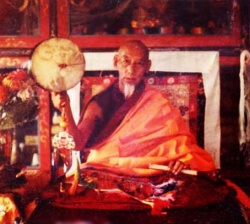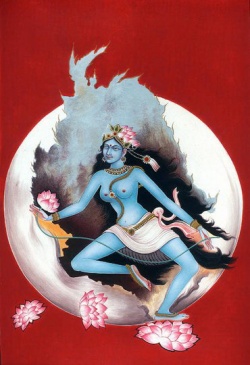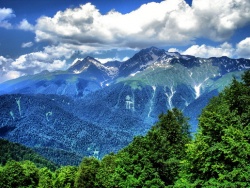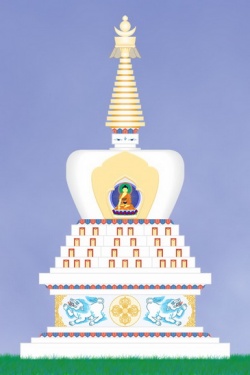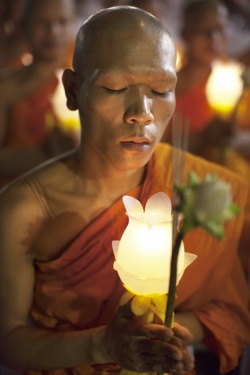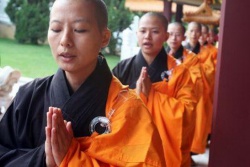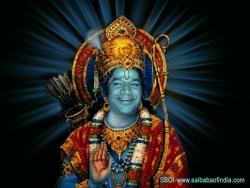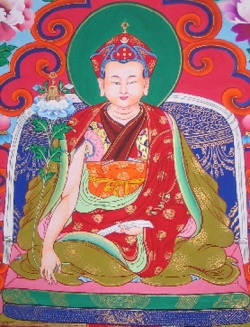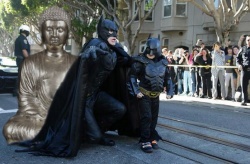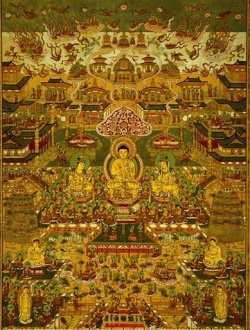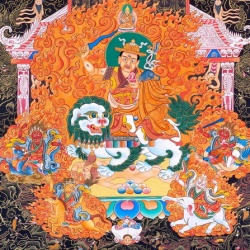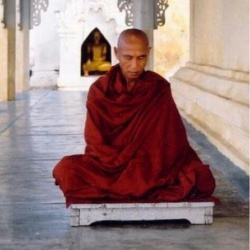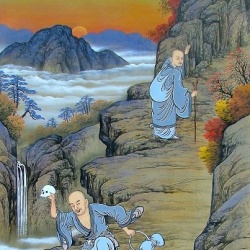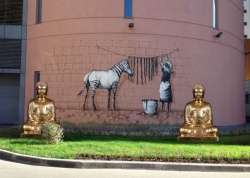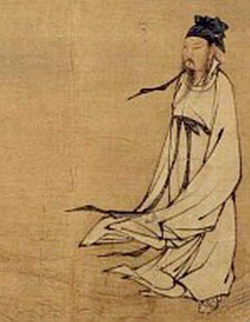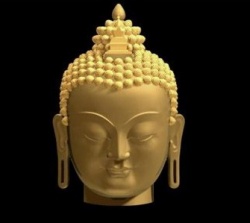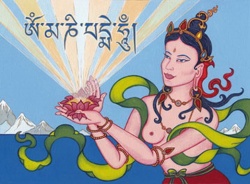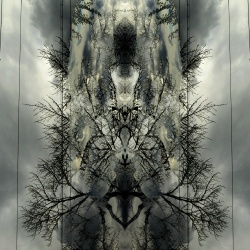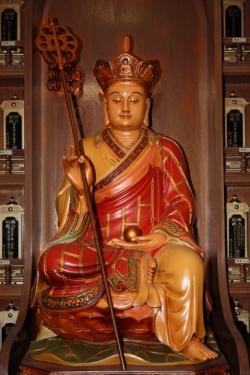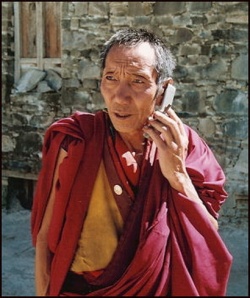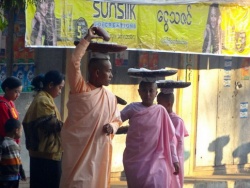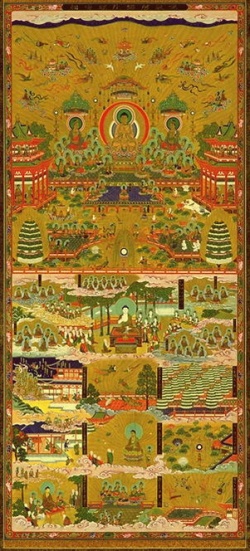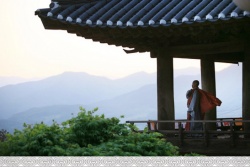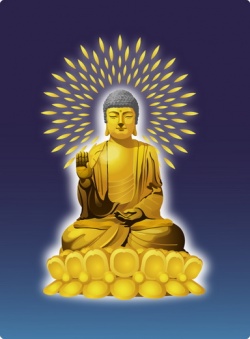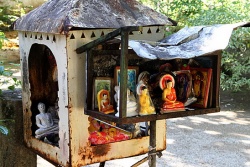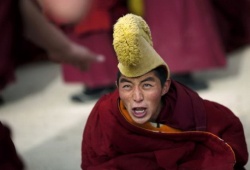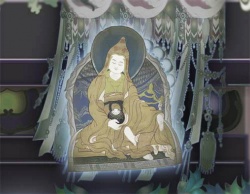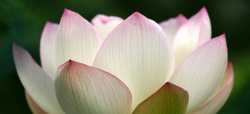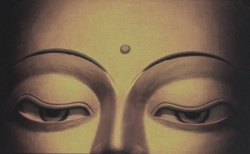Kyabje Zong Rinpoche: Birth, Death & Bardo
Translators Introduction
This small teaching was given by Kyabje Zong Rinpoche at the request of a few westerners who were puzzled about descriptions given by people who had “come back from the dead” after cardiac massage and the like. Reports about such people having visions of
divine beings embodied in spheres of light are not uncommon. Some people therefore have turned to the Tibetan teachings on death and rebirth. However, most of us have read translations of the so-called “Tibetan Book of the Dead”, while
being ignorant of the oral tradition that also has been handed down with this work and the many similar books of the other sects.
The version that is known in the West is of the Kagyu sect. Kyabje Zong Rinpoche has made a great study of the Gelugpa tradition of this genre, and is a lineage holder of many practices associated with this. Thus he is extremely well qualified to
comment on such reports from the West, and his answer is not only completely authentic but is also backed up by an enourmous amount of practical experience.
There are many Westerners who believe that the bardo (or “intermediate state between death and rebirth”) follows the fixed pattern outlined in the “Book of the Dead”. As Rinpoche shows in the following, this is far from the case, for the book only
deals with the typical example of people dying of sickness and old age. Also covered are such topics as spirits and mediums, which will also be of interest to many.
This article covers a vast range of subjects in a small space. It includes such important Mahayana Buddhist teachings as the three types of motivation to follow the practices. There are many other aspects of the Path to Enlightenment that are also
implicitly covered in this teaching, which if pursued will lead the reader closer to the final goal of all beings, Full Enlightenment.
Thus, this teaching will not only answer many questions that one might have about death from the Tibetan and Buddhist point of view, but will also, to the intelligent reader show a way to lead a useful life for others.
A Short Biography of Kyabje Zong Rinpoche
Venerable [[Kyabje Zong Rinpoche Losan] Tsundu Thupten Gyaltsen]] was born in 1905 in the village of Songo, in the Nang-Sang District of Do-To Kham, Eastern Tibet, into the Nyen Nang-pa Family, near the place where his two previous births, as Tenpa Thuntsok and Phuntsok Chopel, had taken place. His father’s name was Jampa and his mother’s name was Sonam Yangzom.
Near the house of his birth stood a fruit tree which was seen to bear fruit when Rinpoche’s incarnations were alive, but would not bear when he was not on earth.
From birth Rinpoche showed many extraordinary signs. Unlike the other children, his efforts at learning, writing and at memorization required very little effort, and he understood the texts simultaneously to reading them. Thus he studied many texts in the monastery of Nang Sang, near his place of birth.
In 1916 he left his birthplace for Lhasa, Central Tibet. This journey took about three months. Here he entered Ganden Shartse Monastery, one of the three great Lhasa Monastic Colleges. Under many of the greatest living Tibetan masters he studied Tsema (Reason), Parchin (Perfection of Wisdom), Uma (Voidness), Dzö (Metaphysics), and Dùlwa (Discipline). Thus through memorization, recitation and debate he became extremely renowned.
In 1928 Rinpoche appeared before His Holiness the Thirteenth Dalai Lama for his examinations and in 1929 was honoured with the degree of Lharampa Geshe, a sign of total spiritual proficiency in the Sutrayana Methods.
Thereafter, Rinpoche entered the glorious Upper Tantric Monastery where he studied the entire field of Tantras. In this way he became a perfect master of all the teachings of Sutra and Tantra.
In 1937 at the wish and advice of Radrang Rinpoche, Rinpoche accepted the abbotship of Ganden Shartse College, a position at which he served until 1947. During his term he built a new debate stage, reconstructed the old residences of the monks and maintained the monastic discipline perfectly. In 1947 on the occasion of Sangphu Yarchö (an occasion of prayer) he made great offerings to 10,000 monks
From 1947 until 1950 he went to Phagri where there was a monastery called Richung Poto. There he benefitted many sentient beings through his profound teaching. In 1950 he visited Tsari in Southern Tibet. At that time many auspicious signs were manifested. Then he went back to Lhasa. In 1951 he visited Do-To Kham Cha Tring and also his birthplace Nang Sang and other places, where he fulfilled the wish of all people by giving teachings of Lam Rim (Stages on the Path to Enlightenment), Lo Jong (Thought Transformation) and by giving tantric initiations, and by helping them further by performing rituals to eliminate their mental and physical problems.
Then Rinpoche returned to Lhasa where the Red Chinese were very active in suppressing Tibetan culture in the area. This escalated and then culminated in 1959 when the Chinese forces out and out attacked and overthrew the government of free Tibet. Rinpoche left with other Tibetans for India, where he has been residing as a refugee ever since.
In India Rinpoche first stayed at Buxa with many other self-exiled monks of the three great monasteries – Ganden, Sera and Drepung. There he gave teachings, oral transmissions, initiations and so forth.
In 1965, in accordance with the wishes of His Holiness the Fourteenth Dalai Lama, he was appointed as the master of a large group of chosen scholars representing all four sects of Tibetan Buddhism, who convened at Mussoorie to work out patterns of cultural survival for the Tibetan Refugees in India. In 1967 Rinpoche became the first Principal of the Central Institute of High Tibetan Studies at Varanasi’s Sanskrit University.
In 1970 Rinpoche stepped down from this position so as to move to Mundgod in the South of India. From here, Rinpoche travels throughout the different Tibetan refugee settlements and benefits many sentient beings by his teachings and initiations.
Rendered into English by Losang Norbu Tsonawa
Footnote:
The following teaching by Kyabje Zong Rinpoche was translated by Achok Rinpoche in coordination with Michael Richards and many others. Because of the length of this teaching we will print its second part in our next Dreloma.
BIRTH, DEATH AND BARDO
BY KYABJE ZONG RINPOCHE
Birth, death and bardo: what are these three things? How do people die? You have asked me about this and of course I have to give a meaningful answer. We have to understand what we mean by birth, death and bardo in general. We must know how the bardo is entered. We die, go into bardo, take birth, again die going yet again into bardo. There is an unending cycle of the three; no end to it at all. It is useful to develop aversion to Samsara (or Cyclic Existence) and very good for practice to know this.
Though this is how things are, you have raised the question today of people coming back again into the same body after death. These people say they see a white light but we cannot say with certainty where it is really there or not.
Usually when people die of some sickness or other, and the consciousness is about to leave the body, there is a feeling of being pressed under a huge mound of earth and a feeling of suffocation. They ask the nurse to help them stand up saying “Give me your hand”. This is the time of the loss of one’s vital energy. After some time the dying cannot even make a sound. All of the water element in them starts to dry up: the lips dry and the nose becomes pinched. Later they cannot see nor hear properly. The ability of all the sense organs to function weakens.
When people feel this pressing downwards they are only having in fact a mental experience, just like the seeing of a mirage even down to the flowing of water. It is only a thing of the mind for it is not really seen.
After this someone dying senses something, like blue-ish smoke which too is also experienced just by the mind. Around the smoke flickers a fire like burning straw thrown into darkness. These things fade slowly. A lamp-like still fire is seen, and after that something white, like colour of the rays of the moon. Out of the latter something else glows redish or crimson, like the rising sun.
Suddenly all is pitch dark. He becomes unconscious; no memory at all remains. This unconscious state finishes and the subtle mind crystallizes and becomes clear. Everything is insubstantial to this mind, like the colour of a clear sky before an autumn dawn. During this period of insubstantiality, the consciousness of the person stays in the body for two days in such a state, while realized beings can stay as long as twenty one days if they wish.
The state of bardo is established the moment after the consciousness, which has accompanied us since beginningless time, leaves the body. The person is completely dead.
Now, there are reasons for the above appearance– the smoky vision and the revolving fire, the still lamp, the whitish and red-ish luminescence, and the dawn-like darkness. Why we see them is because of the energy nodes and channels that we have in the body. How does energy flow through these? It would take too much space.
We shall talk now about what there is after death when the consciousness leaves the body. If this is to be reborn as a human being, then the bardopa (that is the consciousness in the bardo state) has human form. If instead it is to be born a deva (or god), then it is of a deva forms; if an animal, then of an animal form. This bardo body has all the normal sense or cognitive powers and it goes wherever the consciousness wants to without stumbling, and reaches whatever he wants instantaneously. When he goes back home and talks to the family, he does everything that he used to do. We, who are alive, remain silent because we cannot see him. He thinks that we are snubbing him and so feels sad. When he walks over muddy ground, his feet remain clean without any dirt, nor are there any footprints in the mud. His body cannot be seen. He does not discriminate between sunlight or moonlight for his body does not have the two Boddhi minds, the white and the red. His body is that of a mind body only.
In the process of conception in a mother’s womb again, all suddenly becomes dark. He experiences heat and cold as he now has the bodily senses. The three delusions of existence, namely attachment, hatred and ignorance, can individually activate in his mind some memory or other. While he is in the mother’s womb for, say in the case of a human being, he can neither see nor hear. His body increase in size slowly under the influence of the wind element. There is pain and suffering. There is cold and heat. If the mother remains hungry he feels hanging in the air. If she eats a lot, then he feels squashed. If she jumps, he feels as if falling into a chasm. If she drinks hot or cold fluids, then he feels hot or cold.
When the nine months are over and if a boy, his head would be to the right of the womb with his head facing the mother’s back. If this consciousness happens to be a girl, then the head is to the left and faces the front. The reasons for this are due to effects when the bardopa enters the womb.
It sometimes happens that, when a mother is giving birth to twins with one sitting higher in the womb than the other, the lower one comes out first, the higher later. At the time of conception, however, the higher one is conceived before the lower one, and in addition there is a slight size difference between the two.
About to be born, he stays upside down in the mother’s womb for seven days. Now there is great suffering. In coming out, he experiences great pain. When he finally emerges he can see, hear, taste and smell. While he is staying inside the womb he cannot eat food through the mouth but instead his food is given through the mother’s umbilical cord which is attached to the placenta. So this is how birth takes place.
Some say there are people who come back into the dead body and some of these see light. If you were to read a certain Bardo Töthul (or Tibetan Book of the Dead) text in one volume, you would see revealed there quite vividly how Bardo is established. Sometimes one will find there exaggerated comments which arouse one’s suspicion, though the rest is perfectly consistent.
The Bardopas who are to be born as devas or humans in happy births have crimson coloured bodies. They see white paths before them as if someone had laid out a white strip of cloth. Other bardopas are for example black and travel dark paths with some going upright, some crawling, and some even upside down and there are also differences between the various bardopas’ way of walking.
After the bardo state some of the bardopas come back to the dead body and they are called “daelog” in Tibetan. We have these daelog in Kham or Eastern Tibet. Once a consciousness is in the form of a daelog he can come and go almost as he pleases. This happens many times and since the bardopas can travel everywhere very quickly they have many stories to tell when they come back. If the body is not taken out of the room within seven days there is a possibility that he may come back.
But there is more than this, for if we were to meditate on the practice called Powa Drung Jug we would be able to leave our bodies and enter into another corpse. It is mentioned in the biography of Gyalsae Drindon Dawa that he entered into a corpse of a pigeon and so went across the river.
[[Jetzun Taranatha entered the body of a dead child and stayed there for three years while he benefitted many disciples by giving teachings and so fulfilled the true purpose of many sentient beings by leading them further along the path to liberation. For three years he kept his own body incorruptible and stored safely away. The blessed body of the dead child was returned after he reentered his own body. He did this no less than six times. If one has achieved Powa Drung Jug, then this is possible.
Ordinary beings can enter their own dead bodies during the bardo but they cannot prevent decomposition, and can enter only if their body is safe and intact. For example, if the head is cut off then the bardopa cannot reenter the body. There are other cases where the bardopa cannot enter an intact body because his own karma, relating to that particular body, is exhausted. He would not even like to come near to it as he would find it repulsive, dirty and reeking of a foul stench. This is rare. No doctor could make him come back by either medicine or ritual. Thus by the force of their karma it would be possible that one or two people might be able to come back from death.
The above is how the bardo state is generally established.
If someone meets a violent death such as being shot, beheaded or drowned, then he will not experience the smoke mirage with the revolving fire and so on because such a death stops him from recognizing these phenomena, and prior to the bardo the other signs of death do not appear clearly. It only happens to those who die of illness that such signs appear.
If one has so much bad karma that one is to be born in the hell realms, then one is tormented by the final illness. One cannot pray to the three Jewels of Refuge (i.e. the Buddha, Dharma and Sangha) and cannot even remember one’s daily prayers. Such are the disadvantages of the person with little virtue. At such a time one should really try to be calm. However, the person of little virtue sees, just before falling down into the hells, fire activated by his own karma. This creates enormous fear in him.
Once, during Khardampa period, a disciple of Geshe Niu Zurpa cast aspersions on the guru because of lack of faith, and so the guru-disciple relationship was severed. The disciple refused to approach the guru, even though the guru tried to see the disciple by offering many gifts and by calling him to come back. When near death, the disciple could see the guru’s dwelling on the other side of the river.
He would cry in pain: “I can see a fire on that side of the river bank and whenever I see it I feel uneasy. Now the fire is coming nearer and nearer, getting bigger and bigger. And it’s coming to me! The fire is right next to me!” and then stopped breathing. The fire he was seeing was the fire of the hell.
Another example of one with very few virtues was a certain butcher of Golog who killed sheep all the time. Just before he died he could see a hallucination of sheep and all that he could say aloud was “Baa, baa”.
Those with good karma are happy when they die. They are not tormented by sickness for the pain is slight. They can pray to the Three Jewels and their own guru or lama. A person dying this way will take a happy rebirth.
King Bimbisara, the Elder, who built and offered to the Buddha the Garden of Aramikagama, heard on his passing music of the devas and was born after his death in the deva realm. While he was dying he could only hear transcendental music, despite his servants’ playing of different types of instruments, for before the music of his musicians could reach his ear, the music of the deva drowned it out. He was born in the deva realm of Chandvara Maharajikas.
The young King Bimbisara was imprisoned and starved by his own son Ajatasatru. When the king was about to die, he could see the Buddha who was walking with his disciples, for this the city of Drawasti, through the window of his cell. All he could do was generate intense faith in the Buddha, for he was otherwise helpless. The pretender, Ajatasatru, asked after the King to find out what he was up to. The jailor replied that the King was looking through his window. So the window was bricked up. With no window to look through, the King felt very lonely and very near to death.
The Buddha urged Mahakashyapa to think of the King Bimbisara. Mahakashyapa at once gained entry into the prison and once inside gave the message of the Buddha.
“The Buddha says that it’s your accumulated karma that has caused this to happen to you and it must be experienced. You must come to terms with your karma.”
Through this small teaching, the king realized that he was suffering because of his karma. He died with strong faith in the Buddha and could also hear the music of the Chadvara Maharajikas. He was born of the deva Kubera; while today he is the son of another such deva and among the many gods of wealth. When we say such prayers as Kangso, we are saying them to Bimbisara the Younger. Such types of happy deaths are in fact many. On the other hand, with the accumulation of black karma, there are many who fall straight down to hell.
In ancient times, King Videha killed as many as 60,000 Shakyas, through the trick of summoning them all together. He sent out one of his man to listen to general rumour, afraid that the Buddha would feel anger and even curse him (for the Buddha was a Prince of the Shakyas). The man heard the Buddha as saying that for killing 60,000 Shakyas the King would die in seven days, consumed by the fires of hell.
When the servant gave this message, the King said, “We shall come to no harm for we shall go to a place where there could possibly be no fire. Then we shall prove Him a liar” This proves that he had no faith at all in the powers of the Buddha in seeing the future.
He had a great barge made and lived in it along with his Queen. Six days passed by. But the Queen had a number of precious stones in her crown and one of them was the Precious Gem of Fire. At the day-break of the seventh day, the rays of the sun made it catch fire. The fire grew and the royal couple started trying to escape, but the fire followed their every move. There was not enough room for escape. All they could shout was “Tshiko, tshiko – burning, burning!” When the King, Queen and barged were engulfed by the flames, they could not even shout this for they fell to hell with their own human bodies. Of course, they would have taken the bodies of hell-beings on reaching there. These things do happen.
Before our Teacher attained Enlightenment, He had been born as a Monkey Boddhisattva. A man, no doubt a hunter, found himself completely lost in the middle of a forest. He was starving. He found some fruit on the branch of a tree. When he tried to reach for these, the branch broke and he fell into a deep pool surrounded by sheer rock. He reached the surface and looked about for any path up. For some of the time he lived on fruit while shouting for help all the while. He was heard by a monkey. This monkey was a previous life of Buddha Shakyamuni who was still on the path of a Boddhisattva. The Boddhisattva Monkey pondered on the reason for the cries: it must have been someone and so the Monkey peered over the edge and asked what had happened to him.
“I fell into it. There’s no way out and I shall die.”
“Don’t fear, I’ll do all I can.”
The Monkey brought the man fruit and would carry a stone while clambering up again, doing this until He could carry a stone equal in weight to the man. It was then that He said, “Don’t worry, for now I can carry you.” While the man had become very light from living on fruit, the Monkey had been developing his strength. Thus, one day, He carried the man up, and the man was rescued.
The Monkey said on reaching the forest, “How good it is that you are out of danger. The purpose of my undergoing hardship has been fulfilled. In fact I had much difficulty in carrying the stones. Now I can happily fall asleep. You shall watch for the approach of any enemies.” He fell asleep on the man’s lap.
A thought came into the man’s mind while the Monkey slept soundly. He looked himself over and found that there was not much flesh left on his body. “Without food,” he though, “I cannot reach town. To do that, I feel I must kill and eat the monkey.”
Slowly he lifted the Monkey’s Head off his lap, picked up a rock and tried to strike the Monkey’s Head; the Head of his Rescuer. However the man was so weak that he could not aim the stone properly, for he was trembling. Instead he hit the Monkey on the side. The Monkey awoke and, looking about, asked what had happened. The man was burning with shame, and stood as still as a statue. The Monkey saw the big rock near to Himself and guessed what had happened. The man had tried to hit Him on the Head.
“Now come with me. I’ll see you’ll get back,” He said.
He led the man by a path to where he could see the village. The Monkey warned, “Today you have committed an evil action – the bad karma of Ingratitude. You would do well to purify it.”
With this advice, He sent him down to the village. When the man was far enough away from the monkey he could hardly see Him, the man fell into a pit. He greatly suffered from large boils that covered his body and that itched badly.
The king of that time, while hunting, heard someone shrieking. The King could see the man, but could not tell whether it was a man or an animal because of the many boils on the man’s body. The king asked who he was. The man told his story and said, “Since I’m a person of such evil actions I have now the bad karma of these. This is why I suffer so much.”
Just then, the man fell through a crack in the earth that opened right under him. He fell through it straight to the hell realms. There are some who die like this too.
Even if we practice a little of the Dharma, it can be of immense benefit. When the Lord Buddha was living in Sravasti, He did not go to the country of King Saekhya, to give him his Tibetan name. This king had a minister called, also in Tibetan, Damchen. The account is long though interesting. Originally the minister had been a farmer who would frequently go to the king’s palace. The king was expert in assessing people’s character. After the farmer had once gone back home, the king said, “here we have someone who has lots of gold. I know it from his tone of voice.”
The other ministers retorted, “If he has so much gold, why did he come on foot? He has neither house nor child. He goes to his farm and works there. We don’t think that he has much in the way of gold!”
However, the king said, “Just the same, he has.”
So the farmer was sent for and asked if he had much gold.
Again he was asked, “If you have so much gold, why do you toil away on your farm? You could have ridden here on a horse or you can even ride an elephant when you go here and there.”
“All the farmers,” he replied, “travel on foot and work very hard. It doesn’t seem right to me that I should go on horseback or by elephant.”
This answer pleased the king a great deal, and the king believed him. The king, in fact, demanded that he become one of his ministers.
A long story follows the appointment of Damchen, though I can not tell it all here.
Minister Damchen advised the king to practice generosity, saying, “It’s useless if you don’t practice it while you have wealth.” The king gave away much of his wealth to beggars in the street for a month or so. Even those who only stayed there for the month were given food. So it happened that many people traveled there from the south.
One group had 500 travelers. They were all Tirthikas or non-Buddhists. In coming through the Southern parts they had been stricken with thirst, as they could not get water on the way. They had nearly died. In desperation they went to a nearby tree, the sort of tree that granted all one’s wishes, and cried out for all to hear, “Oh owner of this tree! Be you deva, naga, spirit or nonhuman, please give us water. We shall be dead from this thirst!”
From the top of the tree came a ladle filled with water, and this was poured into a very good pitcher. The Tirthikas drank and so quenched their thirst. Then they went away.
But they had not gone far before one of them said, “Who could it be? Who gave us the water? We forgot to ask!” So, back they came and asked, “Who are you? You have been so kind to us that you have saved our lives. Are you a deva, naga or spirit?”
The being on the top of the tree replied, “I’m a deva. My name is Beautiful Hand. Here’s why I’m a deva. In my previous live I lived in Sravasti. There I was very poor and had nothing to give away. The Noble Householder Anāthapindika was at the time giving away much of his possessions. This made him popular and many people came to him after hearing of it. So my family was on its way to his house. I would sit by the side of the road and show other people the way. I would say ‘This way, this way!’ Because I showed those people the way with a good mind, the merit I so gained meant that I was born in the deva realm. I have the best hand of all the devas, and that is the reason for my name.”
The Tirthikas moved on, but at one of the next places they could not find any food and almost died of hunger. They found another such tree and again shouted at it, saying “Give us some food!”
From the top of the tree came a voice. “Go a little further towards that wall. You will find a pitcher full of food buried beneath a stone. It will be enough for all.”
They went and removed the stone and found the pitcher and ate from it with relish. There was more than enough for all. They filled their own containers with the remaining food. Again they asked who it was that had saved their lives.
“I am a deva,” again was the reply. “In my previous life in Sravasti I took One Day Mahayana Precepts in five parts from the House-holder Anāthapindika. Actually I was at the time a Tirthika who dabbled in Buddhist practices. I went home that night and when I got there, my wife offered me food. I told her that just for today I would not eat any of it, as I had taken Precepts.”
“My wife mocked me saying ‘Your father was a damned meat eater. What on earth made you take these vows anyway? It’s too much for me to take a non-Buddhist following Gautama’s Dharma! I won’t be angry with you any more if you take some food. If you don’t, I’ll tell some of the other non-Buddhists here and they’ll give you a real rough time!”
So, he broke his Precepts though it was not his fault. He was born in that deva realm where the sun and moon are to be found. If he had kept his precepts pure, he might have been born in the highest of the god realms, the 33rd quadrant. It was merely through the eating of food that night that he was not born that high.
The Tirthikas conferred amongst themselves and reach, with difficulty the conclusion that while practicing their own religion they had not one single result in this life, while those who practice the Buddha’s Dharma, even if it were only a one day vow and that broken to boot, were born in the deva realms. Amazed by this, they wanted to see whether they could get these precepts or not. They discuss this all of the time while they were going through the South.
At last they reached the place where the king and his ministers were giving away their possessions. While they rested they were asked about any news of distant disturbances. They told their story and said that they were going to Sravasti to see Anāthapindika, and that they wanted to take these precepts from him. Another told them to wait two or three months till autumn, and then go there. They did this, and when they got to Sravasti they found Anāthapindika, told him their story and requested for One Day Precepts.
Anāthapindika asked them, “Do you want to take these from me or the Guru who gave them to me?” They replied that they would know which would be best. He took them to the Buddha. All 500 took vows and also had the Refuge Vows conferred upon them. They were taught of Sunyata, despite their being Tirthikas, and became Aryas for they saw the truth of the mode of existence of all things. They also attained that place, Nirvana, of those who have gone beyond all cyclic existence.
Even if one breaks one’s Precepts, one takes birth in the deva realms. One will die peacefully if one accumulates enough good karma. If one had this accumulation and can pray at the time of death, then one will die without the immense torture of illness. If one has enough faith at the time of death to remember one’s guru and the Triple Gem, even though one has really little good karma, one will not go to the lower realms. First of all, one will go to a happy rebirth through the sheer power of this remembrance. Thus when we talk about the bardo, the most important thing to remember is to do something beneficial at the time of death. To talk of people seeing white or black rays of light when they die or that people have risen from the dead is only idle talk; it is not beneficial practice. Though only gossip, it may indeed be true that some people have seen white light and that people do come back from the bardo state.
Your main doubt is about the working of the bardo process and in particular how a man can return in such a way. On the other hand, there are many cases of non-human beings entering the body after a person’s death.
There are some who die and they remain unconscious for years on end, only to wake in the Hell of Frequent Recovery. The nature of this place is such that the beings in it die and they revive one hundred times a day. The consciousnesses of these hell beings do not leave the do not leave the bodies but remain unconscious for a period of time only to awake again. This is a way that these beings suffer.
In the case of men, there are many daelog who return into the body after death, especially in Kham, for we know that the consciousness can leave the body before the breath stops and then later come back into it again.
The Oracle for the Dromo Dung Gar Monastery, which is in India beyond Sikkim, and who was in fact oracle for the dharmapala (or Protective Deity for the Doctrine) Shungten, left this position and later came to Tibet, becoming later the Oracle of Tshecholing Monastery. At Dung Far was a Bön monastery on a nearby hill, and the Bönpos killed the Oracle with their magic. Word soon got out that the Oracle was dead and people mourned for him.
The Bönpos were elated so blew on trumpets and beat drums. They held rituals in honour of their god and said “Our god has triumphed!” But the deity Shungten entered the dead body and requested people to keep the corpse clean and not to touch it. The body was then not touched nor moved for three days.
When the sun rose from the top of the hill on the third day, the Oracle revived: he had come back. The Dung Gar Monastery burned incense, played instruments and hoisted up prayer flags, saying in turn that their dharmapala had triumphed.
After his recovery, he stayed on for many years acting as the Oracle, though later he discarded his robes and became a layman. So the Monastery looked for a fully ordained monk to act as the medium for the deity. He came to Tibet and stayed at Tshecholing where he received many teachings and practiced the Dharma very well there.
In Kham there is a great deity called Paotrobar who can enter the body of a man. His abode was Logdrama Gutse and he reputed to be the protector of those Khampas who once practiced animal sacrifices. Logdrama Gutse is a high rocky hill that slopes straight into a body of water. From the water you look right up the face of the hill.
The going up the hill is somewhat rough. There are people who go up to burn incense and to ask for money. Someone doing this would take up a set of scaled and would say aloud “Lend me Money!” After receiving it, he would weigh the money, then take it home with the promise of returning it in one or two months. This promise would be made by offering prostrations. If he did not return the money, he would suffer from sickness. Again he would have to burn incense on returning the money. He had to say “I’ve brought the money.” He would have to weigh it again. As the lender is a deity, one would have been able to short change the lender while the money was being weighed on the redemption of the promise. This was done by remarking how great was the weight of the money. The man would not be sick and suffer for what he was doing since the deity would have to believe what the man says.
In the local town, people would make sacrifices and kill many goats. It quite often happens that people recover from sickness when this sacrifice is performed and it was for this reason that it flourished in Kham.
While blood sacrifice prevailed in the country, it happened that an old monk fell very sick and was on the point of death. On dying, his consciousness led him away. He heard somebody saying “Follow me”, and he found himself being lead to Logdrama Gutse. He discovered that the hill was really a big palace having many courtyards with gardens of many flowers surrounded by beautiful groves. As he approached the palace, he could tell that it was a highly complicated building. He found his way to the entrance to the top floor and saw that it was the threshold of the deity’s residence. He began peeping through the curtain of the doorway and was later called in.
The deity had a hare-lip, and was sitting just like a deity should be sitting. After the monk had been called in, the god waves his rosary in the air and then put it down. The deity asked, “Who are you?”
The monk replied, “I have been called and so here I am.”
The god said, “though I didn’t call for you, you may have been brought in by one of my retinue. Let’s leave it be, for I have something to ask of you. Do this one thing and you won’t die. You will recover. You will be able to go back.”
“I’ll do it.”
“Look at my rosary,” continued the god. “It was given to me by Padmasambhava, and it is made of iron. If I recite Vajra Guru, which is the mantra of Padmasambhava, and were out the rosary completely, I shall go to the deva realm Sangdong Peri. Some time ago, the beads had almost worn away to nothing because of the local people’s killing of many goats to propitiate me, even though I do not like sacrificial rituals, I have had to take on all the non-virtues done in my name which have made the rosary get newer. Now I find the beads difficult to wear out. Therefore, you must give the message not to make sacrifice any more. I do not like killing and I myself abstain from doing it. If they still keep up the practice, I shall harm them instead of helping them.”
“Also you must tell them this. When these people practice blood offerings, my slaves get something to eat. Thus they help these people a little but it is not in their powers to help them forever. These are the messages that you must take back with you.”
This monk also noticed that the deity had a statue of Padmasambhava beside his couch.
“Now is the time for you to go back,” the god then said. “You will recover and no harm shall come to you. But you must give the message properly.”
Indeed the monk did go back and recover. While he was reviving he could remember what he had been told. He later gave the message faithfully and was finally able to wipe out this vicious practice in the country.
So we see that there are some people who can come back after death and are led by spirit. There are others who come back by the force of their own karma.
When we die, sometimes it is through the exhaustion of the lifespan and sometimes through the exhaustion of one’s merits collected in previous lifetimes. If one’s lifespan and merits have been depleted then nothing can save one from death; neither prayers nor ritual. All people must die, though if there is a remaining residue of good karma and lifespan, then prayers can do some good. If there is a residue of good karma and the lifespan is exhausted, then the lifespan can do some extent be easily restored. People having such residues can be brought back to life, even if they die of sickness.
Thus it can happen that many people or daelogs come back provided that they have been dead for four or five days and their bodies have been kept clean. They have many anecdotes to tell about different people and about what they have become in future lives, such as so-and-so was born here and so on. Such daelogs are considered holy in my country.
Nevertheless, there is really no certainty about the true identity of the consciousness that returns to the body and starts telling about its actions in the past life. We cannot tell for certain whether it is the genuine consciousness of the dead person or that of some other spirit.
When the dead body comes back to life it behaves very much like the dead person himself. There is a story of when the Precious Minister Padmasambhava was in Tibet. One of the ministers of King Trison Detsaen had died and one of the Bön rituals had been done.
Now there are actually three types of Bön systems: these are called Gyurbön, Khyarbön and Dùbön. The Gyurbön system is a translation of an Indian system combining both Buddhist and non-Buddhist elements by Pandit Shamdag Nagpo (meaning the Wearer of the Black Skirt or Kilt). Khyarbön was established by some non-Buddhists who were able to fly in the air and who settled on the border of Tibet when their monastery was destroyed by a thunderbolt. (The name means those Bönpos who were stranded.) Dúbön was the Bön system established in Tibet. They are expert in making ritual and are effective in dealing with the sick. When the Bön rite Tenpa Sherab is done the dead person is said to come back again. This has been done on those dead person is said to come back again. This has been done on those dead for many days and even as much as a year. The Bönpos shout at the top of their voices while ringing a bell called the shang. After some time, the dead person is supposed to come back. He would be asked whether he had enjoyed what had happened to him while among the dead or whether he had suffered a great deal. He would begin to tell them every story of what he did when he was alive. He would partake of tea, ch’ang and food. By way of offering him a big treat, he would be given a greeting scarf before being exorcised. In fact, all of this was the game of spirits who wanted free food and drink.
However, everyone took all of this on face value only and had faith in this type of ritual, an example of the method of the Bönpos. People reported all of this to the great master Padmasambhava, saying that the Bön system must be very good for there is no such thing in the Buddha’s Dharma. The Bönpos could even call back a dead man and ask him questions about his previous life and he would give the correct answers. Not only would he get something to eat but also he could meet his relatives again. “There is no such thing in the Buddhist Teachings, is there?” they said.
“It could not be the dead person himself,” was the reply.
“It is the dead one; he comes back and you can see it being done for yourself.”
The Bön rite was performed according to the order of the King. After some time, the dead minister of the King came back to life and acted just like the real minister of the King came back to life and acted just like the real minister did in every mannerism and turn of phrase. There was not even the minutest inconsistency that would have indicated that this was not the real ministers alive again. If asked about what he had done at such and such a time, his answer would be absolutely correct. He could tell about all of his actions as a minster.
“When I gave an initiation,” Padmasambhava then said, “I gave you a secret name. What was this name I gave you?”
The body replied, “I cannot know this. When the Precious Guru gave the initiation, I could not attend because I was thrown out before it started.”
This showed that the consciousness was nothing but a spirit that had followed the minister for much of his life. He had been thrown out of the initiation by virtue of some rituals performed as preliminaries, and because of this he was not able to find out what the name was.
After this admission, the body stood up and ran away. Later it became a wolf and even later still vanished into thin air.
At the time of the unmasking of this fraudulent spirit, Padmasambhava declared, “This is the way that we can tell that this was not the real person at all.” When asked what it really was, the Master said it was a spirit who took birth at the same time as the minister had done. This was why he had entered the dead body. In fact all of those people who had come back to life because of the Bönpos ritual were similar cases to this one. Some were these simultaneously born spirits while others were devas. Yet more others were nöjin and drize.
“This is nothing but the tricks of these non-human spirits,” he continued, “for it is quite impossible for the consciousness of the dead person to come back after such a long time. This is because each of them would have had to have taken rebirth according to their individual karma.”
He was then asked about the true rebirth of the minister. Through his special powers of clairvoyance, he was able to tell them that the minister had been reborn as a worm under a cow pat which was to be found near Lhasa. The ministers asked Padmasambhava to show them the worm so as to lend greater credence to his explanation, and took him with them. The great Spiritual Master made the worm remember its previous life, when it was that very minister, by blessing it. He then called it by that secret name and the worm wiggled to him and by so doing answered to the name.
The minister could not help becoming a worm because of the power of ripening karma. Even the Three Jewels were unable to save him for their power and that of the maturing karma of sentient beings are equally powerful. Even if Padmasambhava were to have performed some very powerful pujas on the worm’s behalf, he would not have been able right away to have transported the worm to a Pure Land. There are other such accounts of Padmasambhava.
However, we ordinary beings cannot tell whether a consciousness re-entering a dead body is the real consciousness of that person or not. For example, there are some such spirits who enter bodies and related everything about the activities of the dead person in just the same fashion as he himself would tell it if he were alive. Nevertheless, they would insert lies here and there, such as the seeing of these white, black or red lights. We cannot be sure exactly who it is that has entered the body. Nothing of this sort is to be found in the Teachings of the Buddha.
Such “consciousnesses of the dead person” have been known to enter the body of the local village oracle. Where I come from, we had a woman for the local oracle and the local protective deity a deva, entered into her body. Also she doubled for the oracle of Dhamchen. These two deities would speak truly, just the same. Once the voice of the oracle became very hoarse, so that she quite often made the sound “urr, urr”, she said, “I have eaten many chickens and because of this the head of one is now stuck in my throat.” The consciousness of an old woman who had just died had said this through her. “You should all do prayers for me because I do not have much good karma at all.”
Another dead person’s consciousness entered her and said, “Whenever I recited “Om mani padme hun’, I left out the ‘Om’, could you recite some “Om’s” for me to go with my “Mani’s”?
Our neighbors in the district were the Shangli Family who lives below the path near the river. The father and the rest of the family called themselves together for a meeting. It was at dusk. The father got angry and stormed out. Below their house was the big river. He got to the river and took off his ch’uba, hat and shoes, leaving them on the river bank, then he crossed the river with only his trousers on. He had not returned by the next night and so the family started a search for him. On finding his clothes lying on the river bank, they immediately thought the worst-he had thrown himself into the river. In their pity for him they all swore out aloud.
They invited round some lamas and others proficient in the doctrine, asking them to perform Phowa. The fact that there was no corpse had been forgotten by the family. Instead they went to an oracle who was asked to find the so-called dead father’s body.
To no one’s surprise, the dead father entered the oracle, and with exactly the right voice said, “They insulted me – me, the head of the family. They dared to answer me back after I had worked hard to support them all of their lives. I said one thing and they just would have to say another.”
All of this was having just the right effect.
“I made myself scarce, went to the river and jumped right in. Now I’m so cold!” After this tale of woe, he left, leaving the whole family in tears. All they could think was that he had done himself in and as a result been born a spirit.
After the lapse of four or five days’ stay in the rocks, the father came back. This story is not unique and shows just how difficult it is to distinguish exactly who it is who “speaks from the grave” to use a Western expression.
There is nothing of the bardo state in the Teachings of the Buddha, Knower of all phenomena, whether belonging to Samsara or Nirvana, whether manifest or non-manifest, or whether belonging to any of the Three Times – Past, Present or Future – and who knows exactly the true mode of existence of all.
Many scientists today do useful experiments. However, if they cannot see anything, it does not exist for them. In this they resemble the Carvacas of old, for they have nothing to say about the next lives, nor do they know anything about devas, spirits and such as these things cannot normally be seen. On the other hand, if something can be seen, they deem it worthy of experimentation. These are mainly useful and accurate, and the conclusion they draw are sound.
So to return to the main subject, this is what the texts have to say on the subject. To tell the truth, there are many others well versed in the Dharma who also know as much as I do in such things. Their scholarship is every bit as good mine except in the fact that I am very old and have picked up some stories here and there. So you would do well to ask them about this subject.
BIRTH, DEATH AND THE BARDO; PART TWO
BY KYABJE ZONG RINPOCHE
Question: (by one of the listeners to the teaching given in the last issue): Would it be helpful to recite the Tibetan Book of the Dead (*Bardo T’ oedrol) to someone who has just died?
Answer: When you recite the Tibetan Book of the Dead, if the deceased’s consciousness happens to be nearby he will hear it. If you recite it in Tibetan and he did not understand Tibetan in his last life, he would not be able to understand it, in most cases. If he does understand the language in the Bardo state, who is to say that he will stay to hear it through to the end? You can never know where he might be because he moves to and fro like the breeze. He also may not be paying attention even if he is present. And even further, how long is he going to remain in the Bardo? That is another question altogether, for until he is reborn he remains in the Bardo.
If he has heard then it would be useful, but whether or not he way paying attention to it cannot be known. We are often inattentive when we listen to the teachings while we are alive. How much more would this be so for mere consciousness!
I won’t say that reciting the Tibetan Book of the Dead would be useless. That is not the case. Superficially, its subject matter appears to be about the Bardo, but this is not the whole story. It also says such things as the being in the Bardo should not remain attached to his relatives and parents of this life now that he finds himself in the Bardo. Also he should call to the three Jewels with sincerity. There is such talk about a white light appearing and how he should not be afraid of it as it is the radiance of the Five Dhyani Buddhas or the Five Wisdoms and so forth. I myself have no idea whether these things will appear to one or not. If they are not understood by people when they are alive, it is very hard to expect a Bardo being to understand it.
If holy mantra were to be recited, or the appropriate rituals done properly with the merit so generated being dedicated to the good of the dead person, it would be of more substantial benefit. Moreover, you could do these according to the Tantra, if the Tantra is flourishing in the area. For example, if the body is still available, and you wish to have a purification ritual performed, then set up the corpse and get the Purification of the Three Lower Realms done, which is a method which uses the deity Gun-Rig.
First, the old consciousness is enticed back into the corpse by reciting the Words of the Truth of the Three Jewels. Then, impediments to his achieving Enlightenment or otherwise to his liberation from cyclic existence are removed and the method employed is either wrathful or peaceful. White sesame and white sand are blessed through fifteen mantra. It is beneficial to throw these on the dead body. If these were to be scattered in such places as cemeteries, whatever consciousness that belonged to whichever bones touched by these would be born into the god realms amidst falling clusters of flowers, even if that consciousness had been reborn in the hells. At least this is what is said in the tantra itself. In fact these will be beneficial and one can completely rely on these techniques as they relate to those teachings which deal with activities. The disputes as to the classifications of interpretive or definitive teachings relates only to those statements of the Buddha about the view of emptiness. However, those that concern activities are said to be definitive. If done with conviction and faith, they will work.
If you were to write these very effective mantra on pieces of paper, you should place them into the ears of the corpse, or bury them in the coffin, or even tuck them into the winding sheet.
Qualified lamas leave white sesame close at hand and bless them with mantra when they recite their prayers. They also jot down the names of the dead whenever anyone requests prayers to be said on their behalf. At the end of any lunar month they do a purification. They draw the deceased’s’ consciousnesses onto the top of these seed and the purification is then performed. Afterwards, the seeds are thrown away. This too is of benefit.
There are also washing ceremonies. For example, the Three Jewels are reflected in a mirror and this is then washed. When the water is thrown out, such things as “This water is the perfection of generosity in the form of water”, are said. Whatever ritual you perform of Gun Rig, insert the dead person’s name so that it will benefit him. You may say such things as, “May his negative actions collected from beginningless time and especially those related to miserliness be cleansed; may he attain Enlightenment quickly.”
Even the throwing out of the water is useful to him, as is the cleansing of his ignorance by saying the powerful words of truth about emptiness. In addition there are fifteen verses which also should be recited about the major deeds of Buddha Shakyamuni and how he achieved the great qualities of body, speech and mind, the destruction of the four Maras and the turning of the Wheel of Dharma. You should hope that these will all prove auspicious for the deceased. There are three further verses of auspicious songs to the Three Jewels.
While these are recited, the best things to do would be to throw flowers on the body and think that it purifies his ignorance. If you want to go into even more detail, you can recite more verse which show the stages of the paths to high spiritual states such as the give paths to liberation. Then he can be allowed to enter a mandala to receive initiations. After all of this, through the force of contemplation, his consciousness should be forcefully transferred to Sukhavati Pure Land. The mantra are now burnt. This type of purification includes all seven types of purification and so must be of some use to him.
You should give alms to the poor on his behalf, or make offerings to the Three Jewels or to the Sangha in particular. (In fact in Tibetan communities you quite often hear the monk responsible for the upholding of the monastic discipline reading the list of requests for prayers to be said.) Any virtue done in his name will be of some help to him. However the most helpful thing of all would be if he had done something virtuous for himself while still alive. That is very direct and anything else done later is indirect.
If all of the above have not been done effectively, they are merely mumblings. Take the example of one born into the hells. If the purifications are not effective he may not regain anything like a human rebirth again. At the very least he may gain a little relief, such as feeling a cool breeze when the intolerable heat of hell is at its worst. If you want the ritual to be done seriously, you should request the purification from a properly qualified practitioner, as Tantric practices are supreme methods in their power to purify.
There are some people who hold wakes for the dead, invite their friends and kill goats and chickens for a big feast. As all those negative actions are done in the name of the dead person, they could completely reverse any good actions done for him and could be disastrous.
Gun Rig practices are done especially when people die and they are highly valued by Tibetans, but instead you can request for Guhyasamaja, Yamantaka or Heruka practices to be done. In these cases, one just blesses white sand and sesame, sprinkling these on the body if available. If this is not possible, one of his bones, a fingernail, hair or some unwashed clothes will also do. This is why, when purification is request, people give the unwashed clothes with that person’s name on them. This is so that the purification can be performed on the clothes, not so that they can be sold for some spare cash! If the body has been disposed of, the family offers cloth and will not accept it back, for that is the tradition. If you have the bones and offer them instead, there is no need to offer cloth, particularly as this is not in accordance with the ritual. To offer cloth on top of the other is merely being greedy.
You need’t feel afraid if the dead person revives. The body heat re-gathers first, and later he begins to breathe. After that, he recovers much like a sick person. However, if the corpse becomes a rolang (literally, “a risen corpse”) it is generally due to so-called evil spirits. The corpse begins to swell when these spirits enter the body. Rolangs are of different types and some even talk like humans. Others also eat and tell lies. If the body is becoming a rolang, it is usual for the head to slowly move. The body takes a peek to see if anyone is watching. Then it opens both eyes and stands up. After this, it cannot bend any more. Now it harms people. People die instantly when it says “Ha!”. If it cannot kill, then it tries to damage. It hits people or breathes on them, and they may die. There are certain signs which indicate interferences to the dead body before a rolang occurs. One is that on lighting a butter lamp, it does not glow but gives off “blackish” light. Another is that whenever you look at the dead body, it seems to you that it is going to stand up. If you throw the blessed white sesame on the head of the corpse, it will be prevented from standing up.
I seem to remember an old man with a large gold earring who died. It was the custom to hold a big wake with plenty of feasting and lots of beer. They say that when the food and drink were served, he sat up once, drank a cup of beer and then lay back again. It was seen by many, in point of fact. Later he was examined and was found to have been harmed by a spirit king who favoured another family. The two families had been involved for years in a law suit. The spirit had been more or less teasing the corpse.
There was one lama of Derge who went to Phowa (see the previous article) on a body. Usually the body does not stand when this is done. While performing the ritual, he sensed that things were somehow not quite right. He met his disciple on the road when he returned. He asked the disciple if he was going to the same house for further rituals. The disciple said he was. The lama said, “If there are any interferences to the body, make strong prayers to your principal guru. It would be more helpful.”
The lama had not been alone in sensing bad omens. When the disciple sat down beside the body, the family sneaked out of the room and silently bolted the door.
Now it was usual for this disciple to shut his eyes whenever he said any prayers. During a short break in the ritual, he opened them and saw that the head of the body had raised itself a little. He took no notice of this, shut his eyes and continued. The next time he opened his eyes, he found that the head was raised even more. Frightened now he tried to open the door, but it was locked. Next he tried to get out by the window but it was too small. He did not notice that he had cut his ear on the window frame and that his ear was bleeding badly. No
